Baby, you can’t drive these cars
December 17, 2012

This 1953 Cadillac Eldorado reflects the design dominance of GM's legendary Harley Earl, who was born and raised in Hollywood.
It just might be the best vintage car collection you’ve never heard of. L.A. County’s Natural History Museum has accumulated some pretty sweet rides over the years. While these wheels aren’t as well-known to the general public as those at the Petersen Automotive Museum, they offer a fascinating look at how Los Angeles’ love affair with the automobile has evolved. Public tours of the collection—stored in a climate-controlled facility in Gardena—are coming this fall, but for now, take a spin through our photo gallery. Photos by Scott Harms/Los Angeles County
That’s the spirit!
December 13, 2012
For some kids, the holidays rarely mean a haul of presents, regardless of whether they’ve been naughty or nice. Organizations across Los Angeles County are holding annual toy drives to help level the playing field for the region’s underserved, sick and homeless children. Here are just a few organizations that are currently seeking donations of new, unwrapped toys to spread holiday cheer.
For 20 years now, Southern California Firefighters have spearheaded “Spark of Love,” a drive that has collected more than 7 million toys for underserved children and teens in the region. Drop off toys and sports equipment at your local fire station or CVS Pharmacy. You can also donate online, and your full contribution will go to toys.
Maybe it’s something about wearing a uniform that makes people want to hand out toys each winter, because the Los Angeles Police Department also holds annual toy drives. Locally, you can donate to the Devonshire Police Activity League Supporters in Northridge. The deadline for donation is Friday, December 14, or you can volunteer at the giveaway on December 15 at 9 a.m. Call 818-885-6432 for details.
Friday, December 14, is also the last day to donate to Children’s Hospital. Call 323-361-8397 for a drop off location.
Children’s Action Network is doing its first ever toy roundup this year with “SantaCAN,” which aims to give kids in Los Angeles County foster homes a holiday to remember. Until December 20, donors can purchase gifts from their online registry. The gifts are taken from wish lists made by the children, so you’ll see what you’re buying and the first name and age of the child who chose it.
The Hollywood Sunset Free Clinic and The Toy Drive for Children are holding their 30th Annual Holiday Toy Drive. This year’s theme is reducing childhood obesity, so they are encouraging gifts that encourage exercise, like basketballs and soccer balls, for underserved children in the community.
And don’t let the calendar dictate your season of giving. You can donate year-round to Los Angeles County’s Toy Loan Program. Sponsored by the Board of Supervisors and the Department of Public Social Services, this program allows children to borrow toys from a Toy Loan Center in much the same way they would check out a library book. Click here for the details.
Motion seeks to change toll lanes fee
December 13, 2012
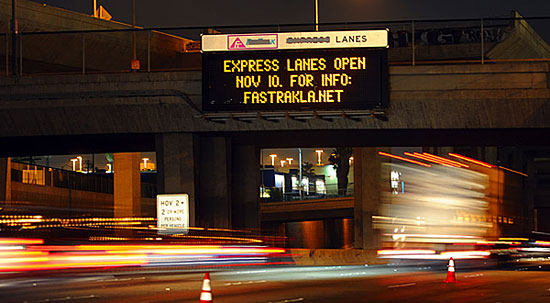
L.A. motorists have been learning the rules of the road for new ExpressLanes. Photo/San Gabriel Valley Tribune
As L.A. motorists adjust to the county’s first ExpressLanes, they’ve had to get up to speed on a new world of transponders, infrared enforcement cameras and pay-as-you-drive pricing.
Thousands of fare evasion citations already have gone out to drivers caught in the new lanes on the 110 Freeway—inadvertently or on purpose—without the required transponders. And although fines were waived during an introductory trial period, motorists face hefty penalties of $154 or more for driving without a transponder—and $401-plus for solo drivers who fudge the setting on their device to indicate they’re carpooling and thus entitled to a free ride.
But it turns out that even motorists attempting to play by the rules by obtaining a transponder and paying required tolls have an additional price to pay—a $3 monthly maintenance fee levied on occasional users who drive in the lanes fewer than four times a month.
That seems unfair to Supervisor and Metro Director Zev Yaroslavsky, who has introduced a motion, to be considered at the Metro board’s January meeting, that would eliminate the monthly fee.
Penalizing the occasional user by levying a fee discourages participation in the pilot program and sends the wrong message, Yaroslavsky said in the motion.
“This fee is unfair and discourages new users,” the motion said. “We should treat all subscribers equally.”
Posted 12/13/12
“Realignment” realities
December 13, 2012
For more than a year, I’ve made no secret of my concerns over the rushed and deeply flawed ways in which Sacramento saddled California’s counties with the duty of supervising tens of thousands of inmates being freed from state prisons. In all my years in public life, I’ve never seen a matter so crucial to public safety pursued with so little regard for on-the-ground realities.
This profound transformation of California’s criminal justice system, enacted under a bill called AB 109, erupted in the news this week in the most tragic of circumstances: the accused gunman in a quadruple homicide in Northridge was one of Los Angeles County’s new AB 109 charges. Exactly how the defendant, Ka Pasasouk, slipped through the cracks—and whether systemic breakdowns may have been to blame—remains under investigation. But already the case has exposed a painfully disturbing fact of “realignment.”
Under the law, only inmates serving sentences for non-violent, non-serious, non-sexual offenses are shifted to the county’s Probation Department for post-release supervision. State parole officers oversee the rest. But the truth is that upwards of half of these so-called N3s were previously incarcerated for serious crimes. Post-release supervision under the new law is based entirely on an inmate’s current conviction, not on those for which he may have served time in the past. Pasasouk was released from prison last January on a vehicle theft conviction. But he had a long history of older offenses, including robbery and assault.
The reason for Sacramento’s legislative sleight-of-hand comes down to this: expediency. The state was under a court order to slash its prison population by 30,000. Had earlier serious and/or violent convictions been thrown into the AB 109 mix, the state would have been unable to hit that number. I can’t help but wonder whether armed state parole agents would be better equipped than the county’s Probation Department to monitor this violent population, products of California’s penal system. I believe this is worth exploring as we move forward.
Of course, any criminal who’s determined to elude supervision will do so, whether he’s being watched by the state or the county. But there’s no question that California’s governor and legislature heightened the public risk by passing AB 109 before our local authorities had a handle on some of the most basic challenges, including how many of the inmates had serious mental health problems, violent histories or even places to live. To this day, more than a year after the law’s implementation, the Probation Department is struggling to keep pace with its mushrooming responsibilities.
Some probation officers have caseloads topping 200 individuals. Many of those ex-convicts, like Pasasouk, have been deemed “high risk.” Although probation officials say the caseload ratio should be closer to 50-to-1, we’ve been unable to hire and train probation officers fast enough to keep pace with the flow from the state’s 33 prisons. The Board of Supervisors has authorized the hiring of 393 probation officers, but so far only 170 have taken to the field, according to department executives. Meanwhile, just this week, probation took delivery of 35 new cars so its officers can make more home visits and compliance checks on “post-release supervised persons,” whose numbers have swelled to more than 11,000 in L.A. County.
This situation is so infuriating that it’s easy to get stuck on what we wish would have happened, rather than on facing and embracing the reality of our predicament. It’s important to remember that the ex-inmates for whom Los Angeles County is now responsible would have been cut loose no matter who was supervising them, and most would have returned to their previous counties of residence. This was not an early release program. While we can, and will, push Sacramento for some legislative fixes, AB 109 is not going away. So I’m hoping that some good might come of all this.
A wide array of county and municipal agencies across the region, extending beyond the Probation Department, have joined together under the hot lights of public scrutiny to tackle a job they know is crucial. Representatives of the departments of public and mental health, for example, are at the table when treatment plans are created for the AB 109 arrivals. Despite gaps that still must be filled, this intensive, multi-agency effort already exceeds the level of collaboration undertaken by state parole officials.
And that, at least, should be encouraging to a public that has a right to expect its government to keep them safe.
Posted 12/13/12
Meteor lovers, look up—maybe
December 13, 2012

The 2009 Geminids, as seen from the Mojave Desert. Peak viewing this year is tonight, weather permitting.
If you’re a night owl, and if the weather cooperates, you just might be able to glimpse the annual Geminid meteor shower at its peak tonight.
Meteors will be blazing across the sky (three per minute under ideal viewing conditions) with no moonlight to interfere with the show this year. Rain and clouds are another matter, however, so if the skies are wet or overcast, the Geminids will be performing undercover.
More details, including an audio report from the Griffith Observatory’s Anthony Cook, are here.
So, if you’re up between 11 p.m. and 4 a.m. and the skies seem clear, bundle up, go outside and take a look. You won’t have another chance until next year.
Posted 12/13/12
Kubrick’s a hot ticket for hipsters
December 12, 2012
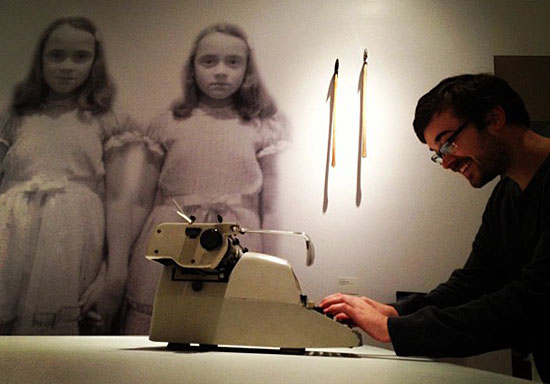
Enthusiastic patrons are sharing their Kubrick exhibition photos on social media. Instagram photo/natalie_matti
The average LACMA visitor this year was well over age 40, but the crowd at the museum’s new Stanley Kubrick exhibition has been looking more like the baby at the end of “2001: A Space Odyssey.”
Twenty minutes before closing on a recent Monday, the rooms were swarming with patrons young enough to be the late director’s grandkids. Here was 17-year-old David Feinziner, in from La Mirada with his parents; there was 23-year-old aspiring producer Kelsey Baca, checking out the great man’s typewriter with her 28-year-old aspiring director boyfriend, Ian Lewis. There was Alexandria Sivak, 28, who works in communications at the Getty, back for the second time since the show’s preview. There was goateed Ben Lee, a 32-year-old musician, whose friend had heard about the show online and alerted him from South Korea.
“Just to be able to see Kubrick’s notes and his vision and his process, and to see the creativity behind the film is just so cool,” marveled Leah Yananton, a 32-year-old filmmaker in a magenta knit trapper hat who had come with a New York friend who had caught the buzz from a twentysomething on Facebook.
“I plan on coming again at least once more before the show is over,” Yananton said, modestly noting that she, too, has an upcoming movie project: “It’s a coming-of-age film in post-production called ‘Surviving Me’.”
Museum officials say it’s too soon to know how the Kubrick show’s demographics will shake out; some 47,000 visitors have seen it so far, but the exhibition, which opened November 1, has only been running about six weeks and won’t close until the end of June.
However, Brooke Fruchtman, associate vice president of public engagement at LACMA, said all signs are that the show is appealing to the same kind of crowd that mobbed last year’s Tim Burton exhibition. That show, which drew more than 363,000 visitors, many in costume, had an audience with an average age of 33, eight years younger than the average visitor that fiscal year to the museum.
“Our Kubrick app is on track to be LACMA’s most downloaded app ever,” she said. “In the first week alone, we had 6,517 downloads.” Meanwhile, pickup on social media “has been huge for Kubrick, with Twitter, Instagram and Tumblr being flooded with images from the exhibition.”
Fruchtman said that, aside from an innovative series of Kubrick-themed pop-up dinners, the marketing of the show has been about the same as for prior ticketed exhibitions. Still, she added: “Sometimes it resonates more than others, depending on the show. “
“Oh yeah, it’s a younger crowd—and they’re all into it, too,” chuckled gallery attendant Rickie Williams on Monday. “They’ve been taking lots of pictures, compared to the older people who come in during the week, who are more often other directors or people who were in the crew or acted in his movies.” (Show business people turned out in force for the show’s opening gala, and star sightings in the crowd since then have included Ben Stiller, who tweeted his admiration from the show, Ryan O’Neal, who starred in “Barry Lyndon,” and “Full Metal Jacket’s” Vincent D’Onofrio.
“I think it’s just that his work is timeless,” said Lewis, the young director, who had taken a break from the cooking show that employs him, and who, with his young friend, Baca, was among the last to leave. “Look!” she breathed on their way out. “There’s his director’s chair!”
Lee, the musician, said the draw for him was “Barry Lyndon.” “It’s my favorite film—it’s so lyrical and touching. I’ve watched that movie more than ten times and I still find something new.”
To Feinziner, the high school senior, the show was a glimpse at a possible future: “I’ve applied to Chapman University, USC and UCLA,” he confided. “I’m planning to go to film school next year.”
Whatever the motivation, Fruchtman welcomes the youthful cohort, which the museum has sought to attract with free “NexGen” membership for people under 18, student discounts, school programs, a hip hop series, teen dances and other youth-oriented programs and events.
But, as any 21st century Los Angeles kid can attest, a thing either captures the imagination or it doesn’t, and so far, it appears that the Kubrick show has broadened the demographic. That’s good news for LACMA.
“Bringing in a younger—and generally more diverse—audience,” Fruchtman said, “is extremely important to us.”
Posted 12/12/12
The chair recognizes…
December 6, 2012
With my final term as chairman of the Los Angeles County Board of Supervisors ending this week, I’ve been reflecting on some of the challenges—and accomplishments—of the past year. I know there’s no shortage of tough issues ahead. But it’s healthy, I think, to take stock of our progress, too.
For starters, the Board of Supervisors this year aggressively moved to fix the seemingly intractable problems in the Department of Children and Family Services. Earlier, last February, amid an uproar over a number of high-profile child deaths and questions about the department’s forthrightness, we named Philip Browning as DCFS’s new director. By all accounts, he has brought a new level of accountability and creativity to the department.
At the same time, the board set the stage for major changes in First 5 L.A., the organization responsible for making sure that voter-approved tobacco tax revenues are being effectively spent on improving the lives of our children from birth to 5 years old. We’ve brought in a new executive director, Kim Belshé—former head of the state Health and Human Services Agency—who’ll ensure that unspent surpluses will no longer build in the group’s bank accounts while youngsters are in need.
We also confronted another problem that was eroding public confidence in the integrity of our local government—brutality by sheriff’s deputies assigned to the Los Angeles County jail system. Late last year, the board created the blue-ribbon Citizens’ Commission on Jail Violence with a mandate to pull no punches in assessing responsibility for the violence and in offering ways to bring it under control.
This September, the panel returned with a verdict, placing blame for these unacceptable breaches of public trust at the highest levels of the department and recommending more than 60 reforms, which are now being implemented. This week, we appointed the commission’s general counsel, Richard Drooyan, to oversee this effort.
On another front, this year marked a watershed in the county’s battle against chronic homelessness.
As perhaps many of you know, I’ve championed a program called Project 50, aimed at providing permanent supportive housing to those most likely to die on the streets of Skid Row. This highly successful effort, which has been replicated throughout my district, served as the foundation for the creation of the Los Angeles County Interdepartmental Council on Homelessness. Last month, the council adopted our first-ever blueprint of how to attack this problem in every corner of the county. Although funding will continue to be an issue, we’ve coordinated the resources and expertise of numerous county agencies that for too long were chipping away alone at this vexing human tragedy.
Transportation continues to be a preeminent issue in our region, and this year we marked a couple of milestones. The first leg of the Expo Line opened in April, bringing rapid mass transit to the Westside for the first time since the Red Car. It’s now attracting record numbers of riders and work on the second and final leg is now well underway to extend the line to Santa Monica. And in the San Fernando Valley, a new four-mile northward extension of the Orange Line opened between Warner Center and Chatsworth in June—giving riders of the popular rapid transit busway even more options and connection possibilities.
We also, at long last, righted some wrongs this year.
In a long overdue move, the board rescinded a World War II-era county resolution urging the forced relocation of Japanese American families to internment camps. “It’s never too late to do the right thing,” said my colleague, Mark Ridley-Thomas, the board’s incoming chairman, who authored the motion. I certainly agree, and I continue to hear from members of the Japanese American community about how meaningful this was to them. The board, at the recommendation of Supervisor Gloria Molina, also issued a formal apology over the so-called “repatriation” of people of Mexican ancestry during the Great Depression, another stain on L.A. County’s history. By recognizing and acknowledging these violations of human rights, we can, I hope, reduce the likelihood of repeating them in the future.
Finally, we continued to recognize and support the arts as a life-enhancing and economically vital part of Los Angeles County life—from the smallest organizations bringing dance, music or visual arts to children to glamorous, internationally recognized players like the Los Angeles Philharmonic and LA Opera, and venues like the Hollywood Bowl, the Natural History Museum and the Los Angeles County Museum of Art.
As Supervisor Ridley-Thomas assumes the chairmanship, I wish him and all my board colleagues a productive and fulfilling year. Together, I believe we can make 2013 an even better year in service of all the people of Los Angeles County.
Posted 12/6/12
Storming the beach as runoff flows
December 6, 2012
The first storm of a Southern California winter can be welcome and even romantic. Not so the aftermath—or as clean-up crews at the beach wryly call it, “The First Flush.”
“Those big storms really clean out the creeks and the catch basins,” says Carlos Zimmerman, assistant chief in the facilities and property maintenance division at the county Department of Beaches & Harbors, and a 33-year employee of the department. “Everything washes down—trees, bushes, firewood, plastic bottles, foam containers. Tons and tons of trash. Dead dogs and cats. Snakes. All kinds of things, you wouldn’t believe it. I saw a BMW come out of Topanga Creek once.”
That’s why, as rainstorms pelted Southern California last weekend, county and municipal crews were hitting the beaches to clean up debris. Their efforts are just one of the ways—from pending litigation to an upcoming Clean Water, Clean Beaches ballot measure—in which runoff will be front and center this winter in Los Angeles County
“Things like education efforts and ordinances against single-use plastic bags and polystyrene containers are making inroads, but it’s obviously an extreme problem,” notes Kirsten James, water quality director at Heal the Bay, the environmental advocacy organization.
Debris, she notes, is just the most visible pollution that courses into the ocean after a rainstorm. (This is one reason why health officials recommend staying out of the ocean for 72 hours after a rainstorm.)
“Heavy metals and bacteria are in there as well,” James says. “Some years, [the First Flush] looks like you’re not even in a First World country—more like you’re at a dump than at the beach.”
Kerry Silverstrom, chief deputy director at Beaches & Harbors, says that county beaches get runoff from more than 200 storm drains, as well as from Ballona Creek, which dumps runoff from miles inland into Santa Monica Bay. Though “trash catchers” installed throughout the system in recent years are intercepting more and more garbage, some still is making it down to the shoreline. Because storm water often continues to flow long after a heavy rainfall, and the debris it carries can churn on the waves for days before being washed up by high tide, the cleanup after a storm usually lasts long after the clouds part.
“That was one of the surprises when I first came to Beaches & Harbors,” says Silverstrom. “I had no idea that there was as much winter work on the beaches as summer work.”
That winter work, done by year-round maintenance crews, can mean anything from tending beach restrooms to piling sandbags to pulling lifeguard towers back from the pounding surf. Kenneth Foreman, chief of the department’s facilities and property maintenance division, says nearly 80 county workers were deployed at a dozen coastal beaches after last weekend’s rain storms, from equipment operators with sand-sanitizing machinery to hand crews who walked the high-tide line, plucking scraps of litter.
The winter crews, he adds, start at 6 a.m. and work every day, rain or shine, including weekends. “We worked Saturday and Sunday, even though it was storming,” he says. “Often by the time the general public hits the beach, they have no idea how dirty it was before they got there.”
There are things the public can do to help limit beach pollution, from proper disposal of motor oil and animal waste to keeping trash out of the storm drains to letting local stormwater coordinators know if flooding occurs in your neighborhood from trash-clogged catch basins.
On a longer-term level, the Board of Supervisors will conduct a January 15 public hearing on whether to seek property owner approval of the Clean Water, Clean Beaches measure through a mail-in ballot. The measure, prompted in part by toughened federal clean water standards, would raise $270 million for stormwater projects in Los Angeles County by assessing parcel owners based on the amount of runoff they generate (about $54 a year for a typical single-family residence.)
Meanwhile, cleanup crews will be fighting the good fight on a landscape that, when the storms hit, still too often becomes long on odor and short on scenery. At a Santa Monica city beach near the Pico/Kenter storm drain, a Heal the Bay staffer blogged last Friday morning that the sight and stench were “shocking.”
“I . . . saw runoff flowing fast out onto the Santa Monica beach, carrying along with it strong smells reminiscent of motor oil and gasoline, hundreds of plastic cups, chip bags, soda cans, an unusually high number of tennis balls, plastic bags (some full of pet waste), bits of Styrofoam, bottle caps, and more urban detritus,” blogged interactive campaigns manager Ana Luisa Ahern, who posted some haunting pre-cleanup photos on the organization’s web site.
“It was a saddening and somber sight, to say the least.”

Kenneth Foreman Sr. of Beaches & Harbors, in jacket at far right, hits the sand after last weekend's storms.
Posted 12/6/12
Beetle mania hits SoCal trees
December 6, 2012

A box elder at Huntington Botanical Gardens shows damage from a voracious new beetle. Photo/Maxx Echt
No one is certain how it got here. The best guess is that it stowed away on a Southeast Asian shipping crate. The first local sighting appears to have been in 2003 at Whittier Narrows. By 2010, it was suspected of killing box elders in Long Beach.
By 2011, it had infested the first of hundreds of trees at the Los Angeles County Arboretum and Botanic Garden in Arcadia and the Huntington Botanical Gardens in San Marino. By the spring of 2012, alerts were being issued throughout the avocado industry.
Now, scientists are warning that a new species of beetle, tinier than a sesame seed but devastating as poison, has gained a foothold in Southern California, threatening scores of tree species, including the native California sycamore and the iconic coast live oak.
“This has been like something out of a science fiction novel,” says Tim Thibault, the Huntington’s curator of woody collections. Thibault says the bug initially was assumed to be an exotic pest called the “tea shot hole borer” that afflicts tea plants in Asia. But when it turned up on more than 100 species, killing some in less than two years, DNA tests revealed that both it and a lethal fungus it carries were new to science.
“It’s been named the polyphagous shot hole borer,” he says. “That’s because the word ‘polyphagous’ means it ‘eats everything’.”
“This is a very big issue for the county at large, and it needs to be coordinated at a high level,” says Brian Sullivan, director of horticulture at Descanso Gardens. “This bug isn’t worrying about what city it’s in.”
So far, scientists say, the new beetle has been found throughout Los Angeles and northern Orange Counties, as far south as Laguna Beach, as far north as Azusa, as far east as Pomona and as far west as Los Angeles International Airport, where it has infested a stand of coral trees.
Whether it has spread to wildlands such as the Santa Monica Mountains is as yet uncertain, but researchers are hoping a January 12 symposium at the Huntington for arborists, gardeners and homeowners will help track the infestation.
“We’re hoping we’ll get a bunch of people out there who’ll look at trees in their parks and neighborhoods and help serve as an early warning system,” says Rosi Dagit, senior biologist at the Santa Monica Mountains Resource Conservation District. (For more information on the symposium, organized by the RCD, the Huntington, the Los Angeles County Department of Agricultural Commissioner and the University of California Division of Agriculture and Natural Resources, click here.)
Akif Eskalen, a UC Riverside plant pathologist who has led the research into the new beetle, says that it probably has been hanging around Southern California for about a decade, unnoticed or misidentified. The discovery of even one new species, let alone two, is highly unlikely; Eskalen, a specialist at the UC Agriculture and Natural Resources/UC Cooperative Extension, says he stumbled on the new beetle and fungus “totally by chance” nine months ago when a desperate homeowner contacted him online for help with a backyard avocado tree that was mysteriously but rapidly dying.
Curious, Eskalen drove two hours to the woman’s home in South Gate. He says he could tell right away that the discolored wood, tiny round holes and powdery white spots were a sign of something unusual.
In his lab on the Riverside campus, he confirmed that the tree was under attack from a variety of the Fusarium fungus borne by so-called “ambrosia beetles,” a broad category of insects that burrow into trees and implant the fungus so that their larvae can feed on it as they develop.
“But ambrosia beetles usually attack plants that are dead or dying,” says Eskalen. “These were attacking bigger, well-watered plants.”
Israeli researchers had already reported that the beetle-fungus combo had severely damaged avocado groves there. Further detective work, by Eskalen and others, revealed that it had infested the weedy, poisonous castor bean shrubs that grow wild around Southern California’s riverbeds, orchards and freeways. Surveys at local arboreta and botanical gardens also showed, however, that the pest isn’t picky.
“We’ve lost two large English oaks, two box elders and a coast live oak,” says the Huntington’s Thibault. “And we have literally hundreds of trees infected—a lot of our native oaks, a lot of coast live oaks. A century-old Japanese maple and a wisteria original to the design of the Japanese Gardens.”
Also, he says, infected trees deteriorate swiftly: A strawberry tree that became a host in the spring of 2010 was dead by October 2011, he says.
One positive discovery is that some trees are less vulnerable than others; the main concern is for the 20 or so species of trees in which the beetles prefer to reproduce. Eskalen says the fungus, carried in the beetle’s mouth, is what kills the trees, and it spreads as the beetle burrows to lay eggs in the heartwood, attacking the plant’s vascular tissue and blocking the flow of water and nutrients.
The bad news, however, is that those vulnerable trees include more than half the street trees being used in California, and some of the most precious native varieties. Nor does the bug appear to be going away soon.
“It seems to have been waiting in the wings until just the right moment,” says Frank McDonough, botanical information consultant at the county Arboretum, noting that some scholarly studies have linked the evolution of ambrosia beetles to prehistoric periods of global warming.
And, says Gevork Arakelian, senior biologist for the Los Angeles County Agricultural Commissioner/Weights & Measures, so far there is no solution.
For now, the only thing homeowners can do is to use local firewood and chip and tarp infected trees on site to avoid spreading the pest or the fungus.
“It’s too late to talk about eradication,” says Arakelian. “We have to concentrate our efforts on introducing a potent biological control agent. This pest is here to stay.”

A century-old oak at the Huntington succumbed to the polyphagous shot hole borer and was removed in May. Photo/Maxx Echt
Posted 11/28/12




















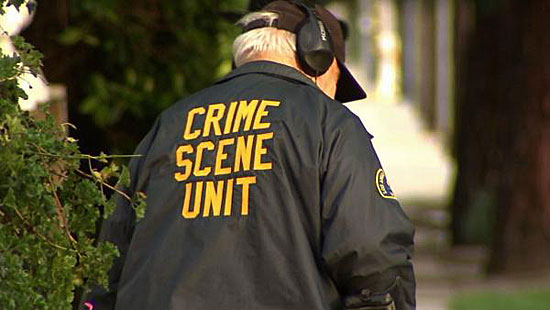
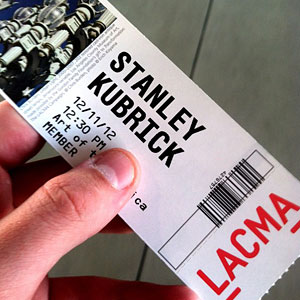
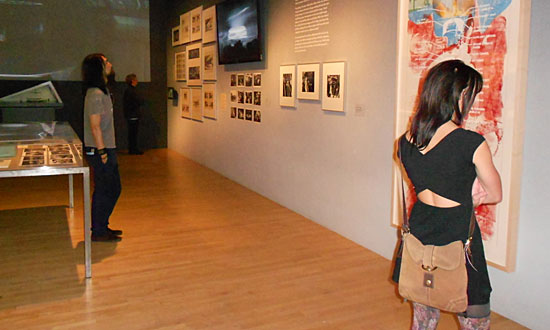


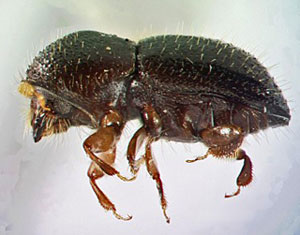





 Check for the latest closure information
Check for the latest closure information








